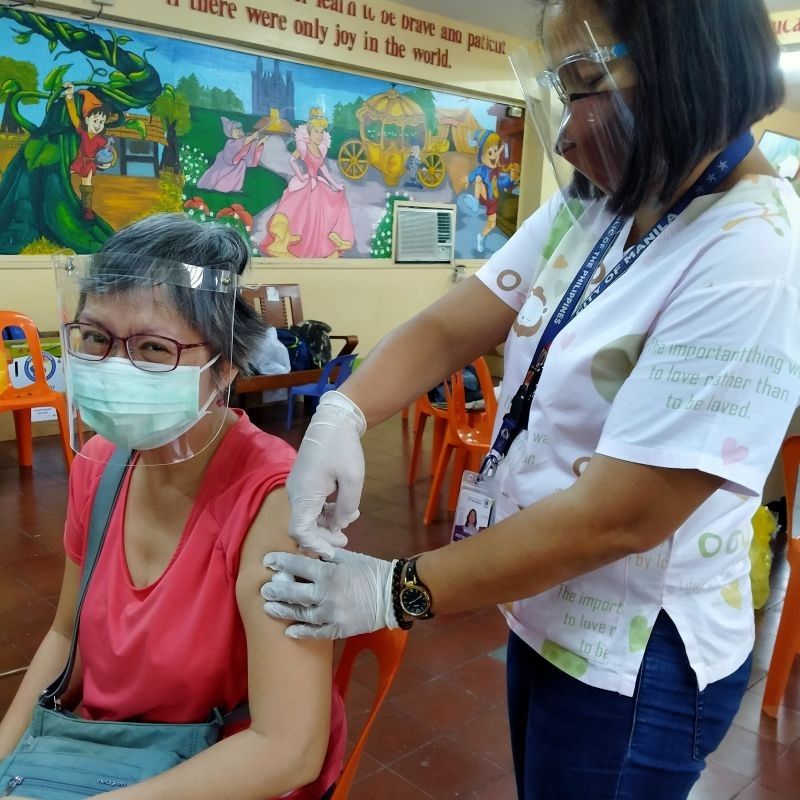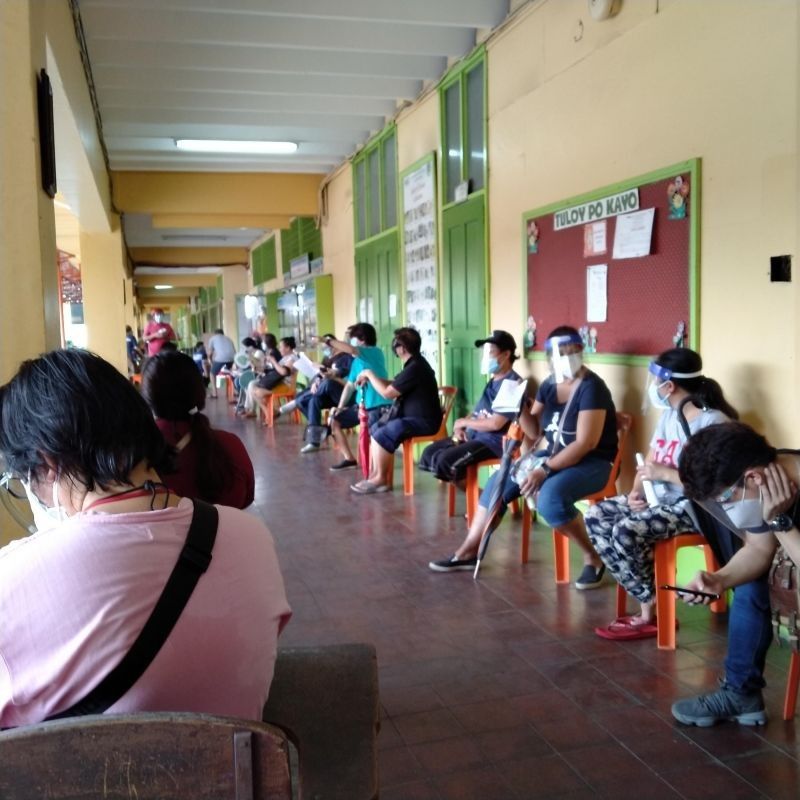Manila vaccine experience or how I became a ‘half-wet log in a campfire’

Thanks to rigorous science and sheer serendipity, this Filipina — who is neither a medical frontliner nor a senior citizen — got her first dose of a COVID-19 vaccine.
Fortune beamed at me on March 31, 2021. I received a free and priceless gift on that day: my first dose of the Sinovac vaccine. The vaccine maker is the third company to receive emergency use authorization in the Philippines.
How did I manage that? Rigorous science and sheer serendipity came together to bring the vaccine into my arm.
“Frontline workers in health facilities both national and local, private and public, health professionals and non-professionals like students in health and allied professions courses with clinical responsibilities, nursing aides, janitors, barangay health workers, etc.” belong to the top priority group for COVID-19 immunization in the Philippines. The Department of Health designated this group A1. “Senior citizens aged 60 years old and above” belong to the second group, A2.
Rigorous science
I belong to neither group. However, I do have high blood pressure, or what the scientists call a “comorbidity.” The term refers to an existing condition that increases a person’s risk for hospitalization or death from a COVID-19 infection. People who have comorbidities already have chinks in the armor of their immunity. If they get the coronavirus, they won’t be able to fight the virus as well as healthy people can.
Dr. John Wong is an epidemiologist and member of the technical working group on data analytics of the Inter-Agency Task Force for the Management of Emerging Infectious Diseases. On March 29, he identified seven comorbidities for inclusion in the priority list for the country’s COVID-19 vaccination program: chronic respiratory disease, hypertension, cardiovascular disease, chronic kidney disease, malignancy, diabetes mellitus, and obesity.
This group of adults with comorbidities not otherwise included in A1 and A2 is designated A3. It is the group to which I belong. I am one of an estimated 14.5 million adult Filipinos whose underlying conditions increase their risk for “unfavorable COVID-19 outcomes,” according to Dr. Wong.
Dr. Wong is also the founder and senior technical advisor of EpiMetrics, a research institution. In a technical brief dated January 5, he and two of his colleagues recommend the following: “Given that around 25.5% of the adult population is at an increased risk of COVID-19 due to comorbidities, the country needs to mitigate the fatal outcomes among this group. Otherwise, we expect catastrophic health and economic consequences.”
Sheer serendipity
I have been singularly blessed to share my life with a partner who is a competent infectious diseases expert and a medical frontliner. I’ve learned — through osmosis, and after reading countless news articles and attending a workshop on epidemiology for communicators last February — that all the COVID-19 vaccines allowed for use in the country are safe and efficacious. The experts at the Food and Drug Authority made sure of that. So, for me, getting vaccinated with any vaccine was a no-brainer.
I also live in the city of Manila, where the city government launched its pre-registration website for the COVID-19 vaccine on January 1. I didn’t hear about the site till the first week of March though. When I checked it out, I saw that that site shows the number of people preregistered for the vaccine and the number of vaccinees. Clicking on the button marked “Manila SITREP” leads to a map showing the number of active cases and their locations, the number of people who recovered from COVID-19, and the number of deaths.
On March 11, I registered online for my COVID-19 vaccine, got my QR code, and read the COVID-19 consent form. It was a painless process.
On the site, I saw that about 97,000 people were ahead of me in the queue. That was fine by me; I am no impatient queue jumper (unlike some Duterte Cabinet officials and soldiers, 13 local officials, and the son of an actress). My best-case scenario was to get vaccinated this year so that I could be counted among the happy immunized herd.
“Herd immunity is the hazy, long-promised end of the pandemic, but its requirements are quite specific,” writes Sarah Zhang in The Atlantic. Jennie Lavine, a biologist at Emory University, likens herd immunity to “wet logs in a campfire.” If there’s enough water in the logs — if there’s enough immunity in a population — “you can’t get the fire to start, period,” she says.
I wanted to be one of those wet logs. I had no idea, though, that my wish would be granted so soon.
At 12:03 a.m. on March 31, I received a text message directing me to go to the school where I would be given the vaccine. I felt like I had already won the lotto! Still, I couldn’t just rush to the vaccination site. I needed to eat a hearty breakfast, inform my boss that I would be away from my computer, and prepare for what I expected would be a long wait.
Sure enough, by 9:55 a.m., the line had crawled out of the school grounds and into the sidewalk that doubles as a toilet for dogs. I stood there, baking in the summer heat, and breathing in the fumes from vehicles stuck in traffic. It was 10:41 a.m. when I got into the well-ventilated school hallway, where I could finally sit.
My fellow vaccinees-to-be and I spent the next couple of hours sitting in plastic or wooden chairs, standing up when instructed, and moving to the next available seat. I settled down to read a book on my phone, something that had long been part of my tsundoku.
Many riveting pages, a snack of 24 grams of wafers and water (I was too afraid of losing my place in the line to leave and buy food), and a trip to a dilapidated toilet later, my blood pressure was taken at 2 p.m. Thankfully, it was only 100/70. I signed the consent form.
A momentary glitch
Minutes later, a doctor was asking me about my high blood pressure and what medicine I was taking for the condition. I showed him my prescription and dutifully answered his questions about whether I have had COVID-19 or been exposed to someone infected with the disease, traveled within the past two weeks, had any allergies, and questions along the same lines with “no.”
I was cleared for vaccination! But first, my QR code had to be scanned on the vaccine registration site. Just as the doctor was doing so, a 403 Forbidden Error message flashed on the laptop screen. He tried again a few more times, but the message did not change.
I stayed calm and suggested that the doctor turn the computer off and on. While waiting for it to boot, I learned from him that 300 people had already been vaccinated that day and that 200 more were in line. The doctor and the other frontliners were wilting in the heat, but there was no one else on deck to take their place.

Finally, the website loaded properly, and my QR code was scanned successfully. I let out a sigh of relief. I was much luckier than former health secretary Dr. Manuel Daylit had been in San Juan City. On March 26, a computer glitch prevented him from receiving his vaccine.
By 2:38 p.m., the vaccine was in my left arm. I silently thanked the Lord for this priceless gift. I was a half-wet log in a campfire!
I couldn’t jump for joy, though; by that time, I was transparent with hunger. Still, I waited for 20 minutes at the site (five minutes longer than the frontliners specified) for observation, in case I suffered any side effects. Thankfully, I had none. So, I went home and wolfed down a much-delayed lunch of longganiza, rice, and microwaved egg.
On April 28, I’m scheduled to get my second dose. I’m counting the days till I become a full-fledged wet log in a campfire. I’ll be sure to bring another engrossing read and a more substantial snack on that day.
Till then, I’ll keep my mask on — and other people at two arms’ length. And I resolve to do that for some time yet. Given the average vaccination rate in the Philippines, it will take more than 10 years to cover 75% of the population. Inoculating that percentage of the population is essential to achieve herd immunity and to safely reopen the economy.
--
Dinna Louise C. Dayao is an independent journalist and editor.



















